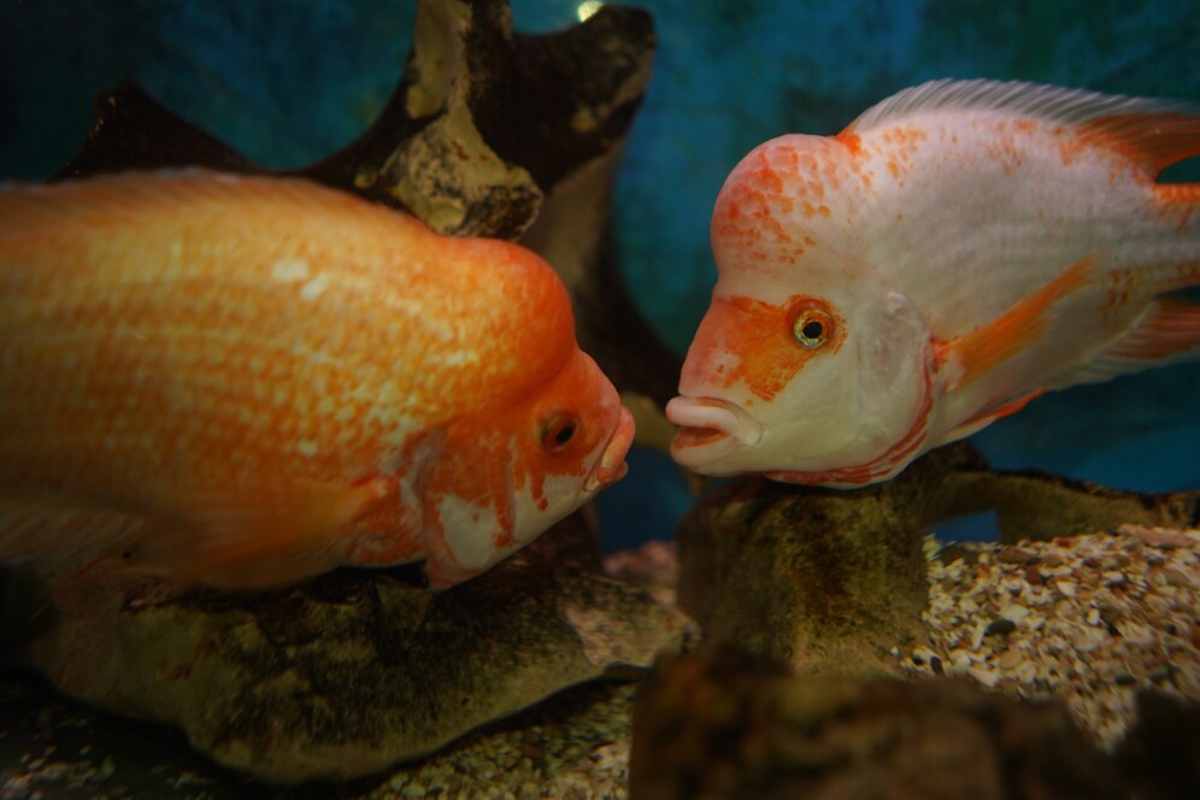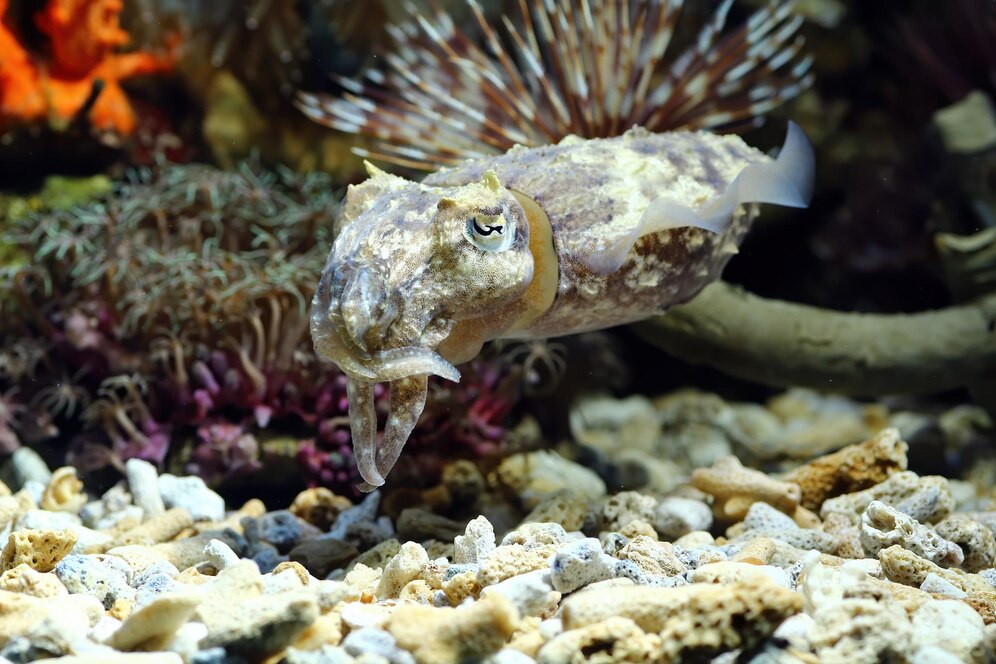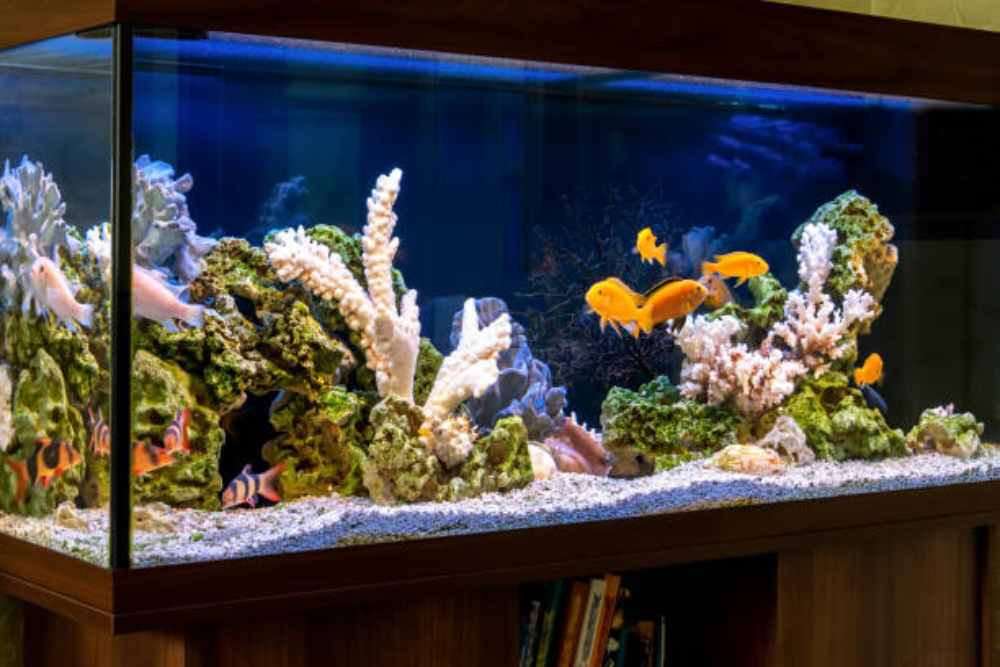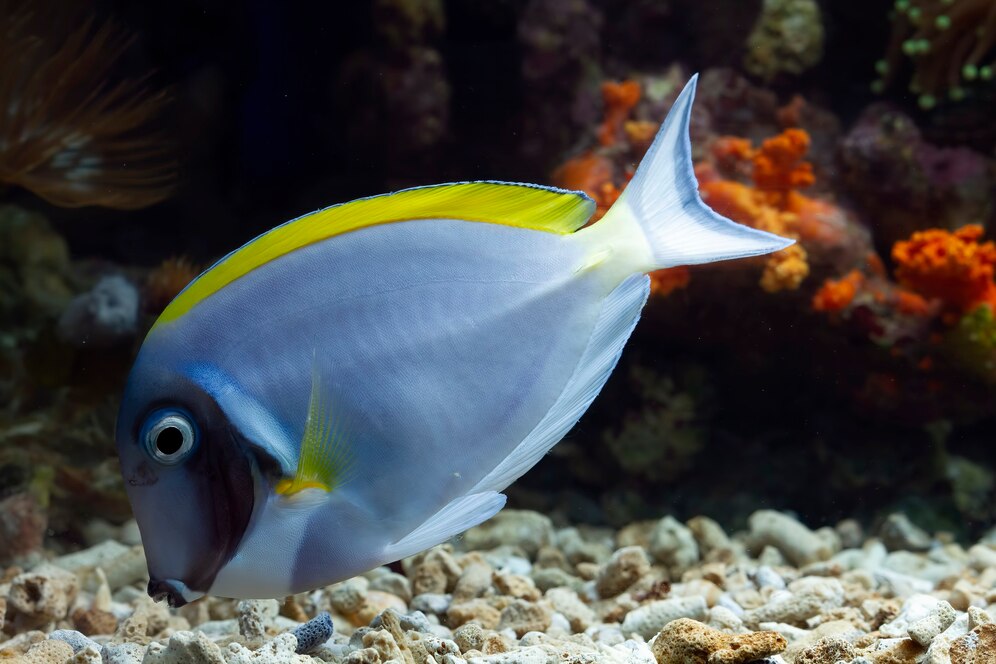
How to Set Up a Saltwater Tank for Exotic Fish: A Comprehensive Guide
Setting up a saltwater tank for exotic fish is exciting and rewarding. With the proper preparation, you can create a beautiful and thriving aquatic environment in your home. A saltwater aquarium lets you display beautiful and unique marine life. You can enjoy fish like clownfish, tangs, and angelfish. Setting up a successful saltwater tank takes careful planning and patience. You also need to understand the specific needs of saltwater fish and invertebrates. This guide will provide all the essential steps, tips, and advice to establish and maintain a thriving saltwater tank.

Quick Guide: Setting Up a Saltwater Tank for Exotic Fish
- Choose the Right Location: Pick a spot away from direct sunlight with a sturdy surface for the tank.
- Select the Appropriate Tank Size: A minimum of 30 gallons is ideal for beginners, but larger tanks are more stable.
- Install the Filtration System: Ensure you have a reliable filtration system. Use mechanical, chemical, and biological filters.
- Add Substrate and Live Rock: Use aragonite sand for substrate and arrange live rock to create hiding spots and swimming areas.
- Mix and Add Saltwater: Prepare the saltwater using a high-quality marine salt mix. Maintain salinity between 1.020 and 1.025 specific gravity.
- Install Lighting and Heating: Use LED lights for optimal coral and fish health and maintain a temperature of 24-26°C with a heater.
- Cycle the Tank: Allow the tank to cycle for 4-6 weeks to develop beneficial bacteria.
- Introduce Your Exotic Fish: Start with hardy fish species like clownfish. Gradually add more delicate species as the tank matures.
Pro Tip: Research fish compatibility thoroughly before introducing new species. This avoids aggression and stress in the tank.
Key Benefits of a Saltwater Tank
Before setting up a saltwater tank, it helps to know why you might prefer it over a freshwater aquarium. Here are some of the key benefits of owning a saltwater tank:
Aesthetically Pleasing and Educational
A saltwater aquarium offers an ever-changing display of colour and motion. The bright colours of marine fish, corals, and invertebrates can make your home a stunning, living artwork. A well-kept saltwater tank offers a calm and fun experience. You can see the fascinating behaviours of marine life. You’ll also learn about the delicate ocean ecosystems.
Unique and Exotic Marine Life
Saltwater aquariums let you keep exotic fish you won’t find in freshwater tanks. Clownfish, tangs, wrasse, and angelfish show how diverse the ocean is. You can also add corals and invertebrates like shrimp and crabs. They are key to creating a real reef-like environment. These creatures can provide endless fascination as you observe them in their habitats.
Important: Don’t rush the cycling process. Establishing a healthy environment may take several weeks. Cutting corners can harm your fish.
Step-by-Step Guide to Setting Up a Saltwater Tank
Setting up a saltwater tank requires a detailed plan to ensure a healthy environment for your fish and other aquatic life. By following these steps, you can create a flourishing tank that will become the highlight of your home.
Step 1: Choose the Right Location
The first step in the setup process is selecting the right location for your saltwater tank. The tank should be placed away from direct sunlight to prevent excessive algae growth. Additionally, make sure the surface where you place the tank can support its weight when filled with water, sand, rocks, and fish. The tank should also be in a location where you can easily access it for maintenance tasks, such as water changes and feeding.
Step 2: Select the Appropriate Tank Size
Tank size is an essential factor in the success of your saltwater aquarium. Smaller tanks (around 20 gallons) are suitable for beginners. Larger tanks (30 gallons or more) are generally more stable and provide a better environment for exotic marine life. Larger tanks improve water quality and help regulate temperature, reducing the risk of harmful fluctuations.
It is important to choose a tank size that fits your space and accommodates the number and type of fish you plan to keep. A 30-gallon tank is generally a great starting point for beginners, but larger setups are ideal if you want to house a wider variety of fish and corals.
Step 3: Install the Filtration System
A quality filtration system is crucial for maintaining the water quality in a saltwater tank. Filtration removes toxins and waste products from the water, creating a healthier environment for your fish. Use a mix of mechanical, chemical, and biological filtration for your saltwater tank.
Mechanical filtration removes debris. Chemical filtration helps to remove impurities such as dissolved organic compounds. Biological filtration helps good bacteria grow. These bacteria break down harmful substances, like ammonia, into safer compounds. Selecting a high-quality filter that suits your tank size and type of inhabitants is essential.
Step 4: Add Substrate and Live Rock
The substrate in a saltwater tank plays a vital role in maintaining water quality and providing a natural habitat for marine life. Aragonite sand is popular in saltwater aquariums. It helps keep pH levels stable and provides a natural substrate for fish to burrow in.
Live rock is another essential component in a saltwater tank. Live rock is naturally colonised with beneficial bacteria that help break down waste and keep the water clean. It also provides hiding spots and surfaces for marine life to attach to. Consider creating caves and open swimming spaces for your fish to explore when arranging your live rock. This will provide aesthetic value and functional hiding places for your fish and invertebrates.
Step 5: Mix and Add Saltwater
Creating the right saltwater environment is crucial for your fish to thrive. To make saltwater, use a quality marine salt mix made for saltwater aquariums. Follow the instructions on the package to achieve the correct salinity, which should be around 1.020 to 1.025 specific gravity.
You can use a large container or a dedicated mixing bucket to mix the saltwater. Fill the container with fresh water and add the salt mix in the correct proportions. Use a powerhead or aerator to mix the solution thoroughly. This ensures that the salt is fully dissolved. Once the water is mixed correctly, add it to the tank not disturbing the substrate.
Step 6: Install Lighting and Heating
Proper lighting and heating are crucial components for the health of your fish and the growth of corals in a reef tank. LED lighting is excellent for saltwater aquariums. It gives the right light for marine life, is energy-efficient, and doesn’t create extra heat. When choosing lighting, think about your fish and corals. Different species need different amounts of light.
A heater is also essential for maintaining the right temperature. Typically, between 24 °C and 26°C mimics the natural conditions of the ocean. Choose a reliable heater for your tank size and keep it well-maintained to ensure a stable environment for your fish.
Step 7: Cycle the Tank
Before adding any fish to the tank, it’s essential to cycle the aquarium to establish a stable and healthy environment. The cycling process helps grow good bacteria in the filter and substrate. These bacteria turn harmful ammonia and nitrites into safer nitrates.
This process typically takes 4-6 weeks, and it’s important not to rush it. During cycling, check water parameters like ammonia, nitrite, and nitrate. Use water testing kits for accurate readings. Once ammonia and nitrite levels have dropped to zero and nitrates are present, the tank is ready for fish.
Step 8: Introduce Your Exotic Marine Fish
Once the tank has fully cycled, it’s time to introduce your exotic fish. Begin with challenging species that handle small changes in water quality, like clownfish or damselfish. These species are ideal for beginners as they are relatively easy to care for and less sensitive to water parameter changes.
Gradually add more delicate species as the tank matures and the water quality stabilises. Research fish species compatibility before adding them. This helps prevent aggression or stress in your tank.

Additional Expert Tips & Common Mistakes to Avoid
To help you avoid common pitfalls and ensure the success of your saltwater tank, here are some expert tips and mistakes to watch out for:
Expert Tips
- Research Fish Compatibility: Not all fish get along well, and some species may be aggressive towards others. Research the compatibility of your chosen fish species to avoid problems.
- Regular Maintenance: Change water weekly. Check water parameters often, like pH, salinity, ammonia, nitrites, and nitrates. This helps keep your tank healthy.
- Invest in Quality Equipment: While quality equipment can be more expensive, it is often worth the investment in the long run. High-quality filters, lighting, and heaters can help save time and money by ensuring the stability and health of your tank.
Common Mistakes to Avoid
- Overstocking the Tank: Adding too many fish at once can stress the filter and harm water quality. Always introduce fish gradually to avoid putting unnecessary strain on the ecosystem.
- Ignoring Water Parameters: Not monitoring water parameters can harm water quality, which can cause health problems for your fish. Regular water testing is essential for a thriving aquarium.
- Rushing the cycling process can harm your tank. This process is vital for a healthy environment. Rushing this process can lead to spikes in ammonia and nitrites, which can be deadly to your fish.
Advanced Insights & Expert Recommendations
If you want to upgrade your saltwater aquarium, check out these expert tips and insights:
Advanced Coral Care
If you plan to keep corals in your tank, it’s essential to research their specific lighting and water flow needs. Corals require precise care and attention to thrive. Some species need bright lights and strong water flow. Choose the right corals for your setup. Then, keep a close eye on their health.
Automation and Monitoring
Think about using automatic feeders, dosing systems, and monitoring devices. They can help make maintenance easier and keep water quality steady. These tools help automate regular tasks, such as feeding and dosing supplements, and allow you to keep a close eye on the health of your tank.
Community Involvement
Join local aquarium clubs or online forums to connect with other enthusiasts. Learning from others can boost your understanding and enjoyment of the hobby.
FAQ: Setting Up a Saltwater Tank for Exotic Fish
How long does it take to set up a saltwater tank?
Setting up the tank itself can take a few days. The entire process, including cycling the tank, takes about 4-6 weeks to establish a stable environment for your fish.
What is the best tank size for beginners?
A 30-gallon tank is typically recommended for beginners. Larger tanks are more forgiving of fluctuations in water parameters. This makes it easier to maintain a healthy environment.
Can I add fish to my tank right away?
No. After setting up the tank, you need to cycle it for at least four weeks before introducing fish. This allows beneficial bacteria to be established, ensuring a stable and safe environment.
What should I do if my fish are showing signs of stress?
If your fish are stressed, check the water parameters such as temperature, salinity, and pH. Stress can happen if fish don’t get along or if there aren’t enough hiding spots.
How often should I perform water changes in my saltwater tank?
Regular water changes should be performed once a week, replacing 10-20% of the water. This helps maintain water quality and reduces the build-up of waste and toxins.
Can I add live corals to my saltwater tank?
Yes, but research the specific care requirements for the corals you want to keep. Corals require particular lighting, water flow, and water quality to thrive.
Do I need to use live rock in my tank?
Live rock is highly recommended. It offers biological filtration and a natural home for fish. It helps maintain water quality by housing beneficial bacteria that break down waste.
How do I know if my saltwater tank is ready for fish?
Test the water regularly for ammonia, nitrites, and nitrates. Once the ammonia and nitrite levels are zero and nitrates are present, your tank is ready for fish.
What types of fish are best for beginners?
Hardy fish like clownfish, damselfish, and chromis are great for beginners. These species can tolerate various water conditions and are generally easy to care for.
Can I use tap water for my saltwater tank?
It’s not recommended to use untreated tap water. It may contain chlorine or chloramine, which can harm your fish. For the best results, use a water conditioner. You can also choose purified or RO/DI (reverse osmosis/deionised) water.

Set Up a Saltwater Tank for Your Exotic Fish
Setting up a saltwater tank for exotic fish is a rewarding and beautiful experience. You can build a beautiful marine habitat by planning well and focusing on details. This space will be fun to watch and suitable for the creatures living there.
Follow the steps in this guide, and you’ll be on your way to a successful saltwater tank. Remember, patience is key, and regular maintenance is essential for success. Take your time, and invest in quality equipment. Don’t hesitate to seek advice from experts or fellow hobbyists.
Start your journey into the world of saltwater aquariums today. Enjoy the incredible marine life that you can bring into your home.


